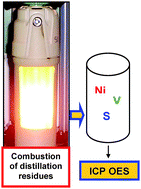Microwave-induced combustion (MIC) was applied for digestion of crude oil distillation residues for further total nickel, vanadium and sulfur determination by inductively coupled plasma optical emission spectrometry (ICP OES). Sample masses up to 500 mg of atmospheric distillation residue (AR) and vacuum distillation residue (VR) were completely combusted using the MIC system. A polyethylene film was used to wrap the samples allowing a feasible combustion process. Ammonium nitrate (6 mol l−1 solution, 50 µl) was used as an aid for ignition. Parameters related to the combustion process, as sample mass and oxygen pressure for MIC were investigated. The type and concentration of absorbing solution (H2O, 5% v/v H2O2 and 1 to 14 mol l−1 HNO3) used to absorb gaseous combustion products as well as the use of an additional reflux step were studied. Diluted nitric acid (2 mol l−1) was selected as absorbing solution resulting in a suitable medium for simultaneous Ni, V and S determination by ICP OES in both AR and VR samples. The agreement to certified values for Ni, V and S was from 99 to 101% for MIC using 2 mol l−1 HNO3 as absorbing solution with a reflux step. Results obtained by MIC for AR and VR samples were also in agreement with results obtained using high pressure microwave-assisted wet digestion. Limits of detection by MIC and further ICP OES determination were 0.2, 0.1 and 2 µg g−1 for Ni, V and S, respectively. It was possible to digest up to eight samples each run. Digestion time was reduced twice when compared to high-pressure microwave-assisted wet digestion.

You have access to this article
 Please wait while we load your content...
Something went wrong. Try again?
Please wait while we load your content...
Something went wrong. Try again?


 Please wait while we load your content...
Please wait while we load your content...